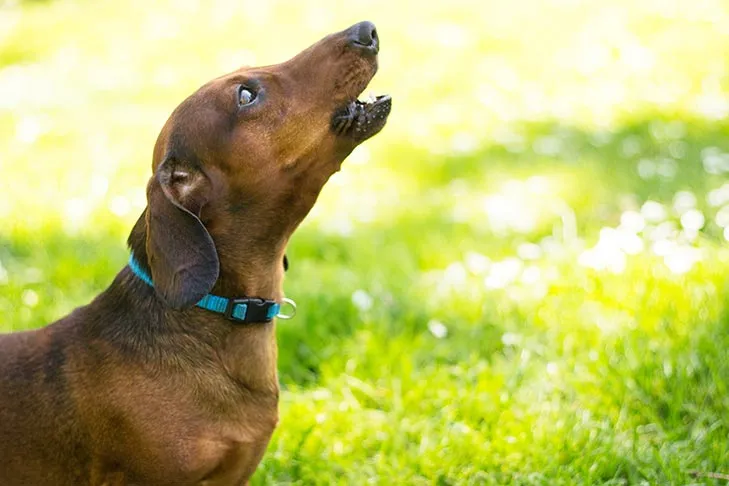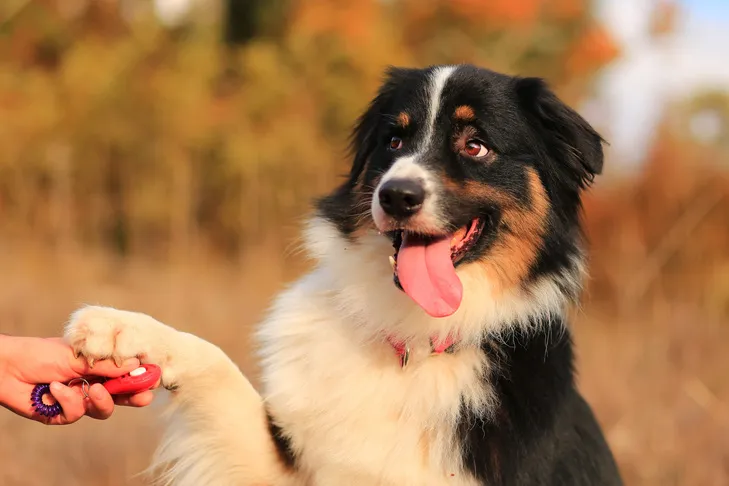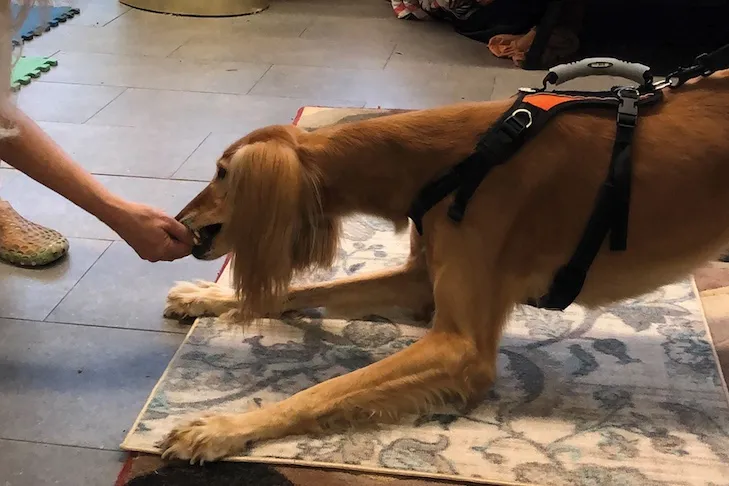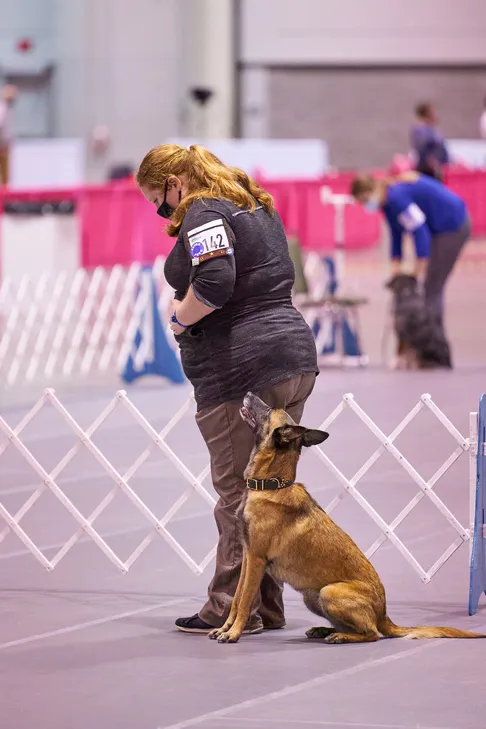Teaching your dog new tricks is more than just a way to entertain; it’s a fantastic method to strengthen your bond, enhance their cognitive abilities, and boost their confidence. Whether you’re a seasoned dog trainer or just starting out, incorporating playful tricks into your routine can be incredibly rewarding. This guide is designed to equip you with the knowledge and techniques to teach your dog a variety of engaging and Fun Tricks To Teach Your Dog. We’ll cover essential principles, step-by-step instructions for several popular tricks, and tips to ensure a positive and effective training experience.
Remember, patience and positive reinforcement are your most powerful tools. Each dog learns at their own pace, so celebrate small victories and keep training sessions short, fun, and engaging. You’ll need treats, a clicker (if you use one), and a quiet space to begin your training journey.
Mastering the Art of Catch
Teaching your dog to catch is a classic trick that not only impresses but also sharpens their reflexes and hand-eye coordination. Start by having your dog sit in front of you. Get their attention with a high-value treat. Gently toss a treat underhand towards your dog. If they successfully catch it mid-air, offer immediate praise and a reward. If they miss, calmly retrieve the treat before they can eat it and try again.
 A Labrador Retriever ready to catch a ball
A Labrador Retriever ready to catch a ball
Repeat this process several times during each training session. Once your dog consistently catches treats, you can transition to tossing their favorite lightweight toys. When they catch a toy, shower them with praise and follow up with a tasty treat. This builds excitement and reinforces the desired behavior. For more advanced catching techniques and how to progress, explore new tricks to teach your dog.
Navigating the “Under the Bridge” Trick
The “under the bridge” trick is a charming way to have your dog crawl beneath your legs. Begin by sitting on the floor with your knees bent, forming a triangle shape. Have your dog on one side of you, and hold a motivating treat or toy in your hand on the other side. Extend the treat or toy under your legs, allowing your dog to sniff it.
As your dog follows, slowly move the lure under your legs towards the ground. Encourage them to move with the lure, which will naturally cause them to lower their body and crawl under. Once they emerge on the other side, offer plenty of praise and reward them with the treat or toy.
After a few successful repetitions, introduce a verbal cue such as “under” or “bridge” as they begin to move. As your dog becomes proficient, you can gradually reduce the reliance on the lure, eventually relying solely on the verbal cue before rewarding them. This trick is a great foundation for other agility-related movements and can be a part of teaching fun new tricks to teach your dog.
Teaching Your Dog to “Speak”
Capturing a naturally occurring behavior is a simple yet effective method for teaching your dog to “speak.” Keep treats readily available. Whenever your dog barks out of excitement, immediately mark the behavior with your chosen cue, such as “talk” or “speak,” and reward them with a treat. Using a clicker at the precise moment of the bark can significantly help your dog understand which action you are rewarding.
 A Dachshund howling
A Dachshund howling
After several repetitions of marking and rewarding, your dog will begin to associate the cue with barking. To prevent excessive barking, it’s crucial to only reward when they bark in response to your specific command, once they have grasped the concept. This trick can be a building block for understanding commands, which is fundamental for tricks I can teach my dog.
Mastering the Leg Weaves
Leg weaving is an impressive trick that involves your dog moving in a figure-eight pattern between your legs. Start in a safe, open space without a leash to avoid entanglement. Stand with your legs wide apart, and have your dog in front of you. Hold a treat behind your legs to lure your dog through. Bend your knees and use the treat to guide your dog to walk between your legs. When they pass through, praise and treat them.
Once they are comfortable, use another treat to guide them through your legs and around one leg, returning them to face you. As they follow the lure, allow them to lick and nibble, keeping them engaged. When they confidently move between your legs and around one side, practice with the other leg. Once they can reliably weave through both legs, begin to combine the movements into a figure-eight pattern.
Gradually fade out the treat lure, using an empty hand to guide them. As they follow your empty hand, introduce your verbal cue, such as “weave” or “legs.” With continued practice, you can phase out the hand lure, and your dog will respond to your bending-knee posture as a physical cue. Once mastered while standing still, you can teach them to weave as you walk slowly, gradually increasing your pace and decreasing the treat lure as they gain confidence. This complex trick adds a dynamic element to your dog’s repertoire and is a great example of new tricks to teach an old dog as well as puppies.
Teaching Your Dog to “Shake Hands”
The “shake hands” trick is a friendly and common way to interact with your dog. Start by extending your hand towards your dog. Ignore any licking or sniffing initially. When your dog paws at your hand, immediately mark this action with praise or a clicker and reward them with a treat. Repeat this until your dog consistently paws at your hand.
 An Australian Shepherd learning to give a paw
An Australian Shepherd learning to give a paw
Now, work on increasing the duration your dog’s paw stays on your hand. Wait until their paw is resting on your hand before clicking, praising, and rewarding. Begin with just a second or two, gradually extending the time as your dog understands. Once your dog consistently places their paw on your hand and waits for a reward, introduce a verbal cue like “shake” or “hello.” You can then flatten your hand and hold it vertically, mimicking a handshake, before treating your dog. Introduce a gentle up-and-down motion with your hand to further refine the trick.
The “Yes” and “No” Trick
This trick creates the illusion that your dog can answer “yes” or “no” questions. To teach your dog to “say yes,” hold a high-value treat in a closed fist. Slowly move your fist up and down, encouraging your dog to follow with their nose, which will naturally lead to a head nod. Reward them when they nod.
When your dog consistently follows your fist, try the exercise without a treat in your hand. Reward the nod with praise and a treat from your other hand. Eventually, the closed fist will become the physical cue for nodding. To teach “no,” use a different hand signal, such as a closed fist with your pointer finger extended upwards. Move your hand slowly from side to side, prompting your dog to follow, which will resemble a head shake. Reward them when they move their head. With practice, the extended finger will become the cue for shaking their head. These are excellent examples for easy dog tricks to teach puppies.
Teaching Your Dog to Bow
The bow trick is a graceful movement that involves your dog lowering their front body while keeping their rear elevated. Start with your dog standing in front of you. Capture their attention with a treat and lure their nose down between their front legs, moving towards their chest and belly. As they follow the lure, they will naturally assume a bow position. Praise and reward them, then toss a treat away from them to prevent them from going into a full down.
 A dog performing a bow
A dog performing a bow
If your dog tends to collapse into a down position, a gentle touch on their stomach just below the loin can cue them that you’re not asking for a down. Once your dog consistently follows the food lure into a bow, transition to luring with an empty hand, rewarding them after they achieve the bow. When they follow the empty hand lure, introduce a verbal cue like “bow” or “fancy.” With practice, your dog will develop strength and coordination to hold the bow longer. You can even evolve the physical cue to you performing a bow or curtsy.
Spinning in Circles
Teaching your dog to spin is a fun and energetic trick. Get your dog’s attention with a treat or toy. Hold the lure just above their nose and move your hand in a large circle. As your dog follows the lure, they will naturally walk in a circle. Praise and treat them. After a few repetitions, add a verbal cue like “spin,” “twirl,” or “around” as they follow the lure.
Next, use the same technique to lure your dog in a circle in the opposite direction. Once they consistently follow the lure in both directions, add the corresponding verbal cue for each. When your dog responds to cues in both directions, you can start using the circular hand motion without a treat, relying on the verbal cue alone. Reward them when they spin. This is a great way to add variety to your training.
Playing Peekaboo
The “Peekaboo” trick is a playful interaction where your dog comes through your legs. Stand in front of your dog, both facing the same direction. Hold a treat to capture their attention. When your dog comes forward through your legs, praise and reward them.
 A dog's head between legs
A dog's head between legs
After a few repetitions, introduce a verbal cue such as “middle” or “peekaboo” as they move between your legs. Use a release cue or toss a treat to move them out of position, allowing for repeated practice. As you progress, you can fade out the treat lure, and your dog will respond to the verbal cue to enter the Peekaboo position. These tricks, when taught with patience and positivity, contribute significantly to a well-rounded and happy canine companion.
